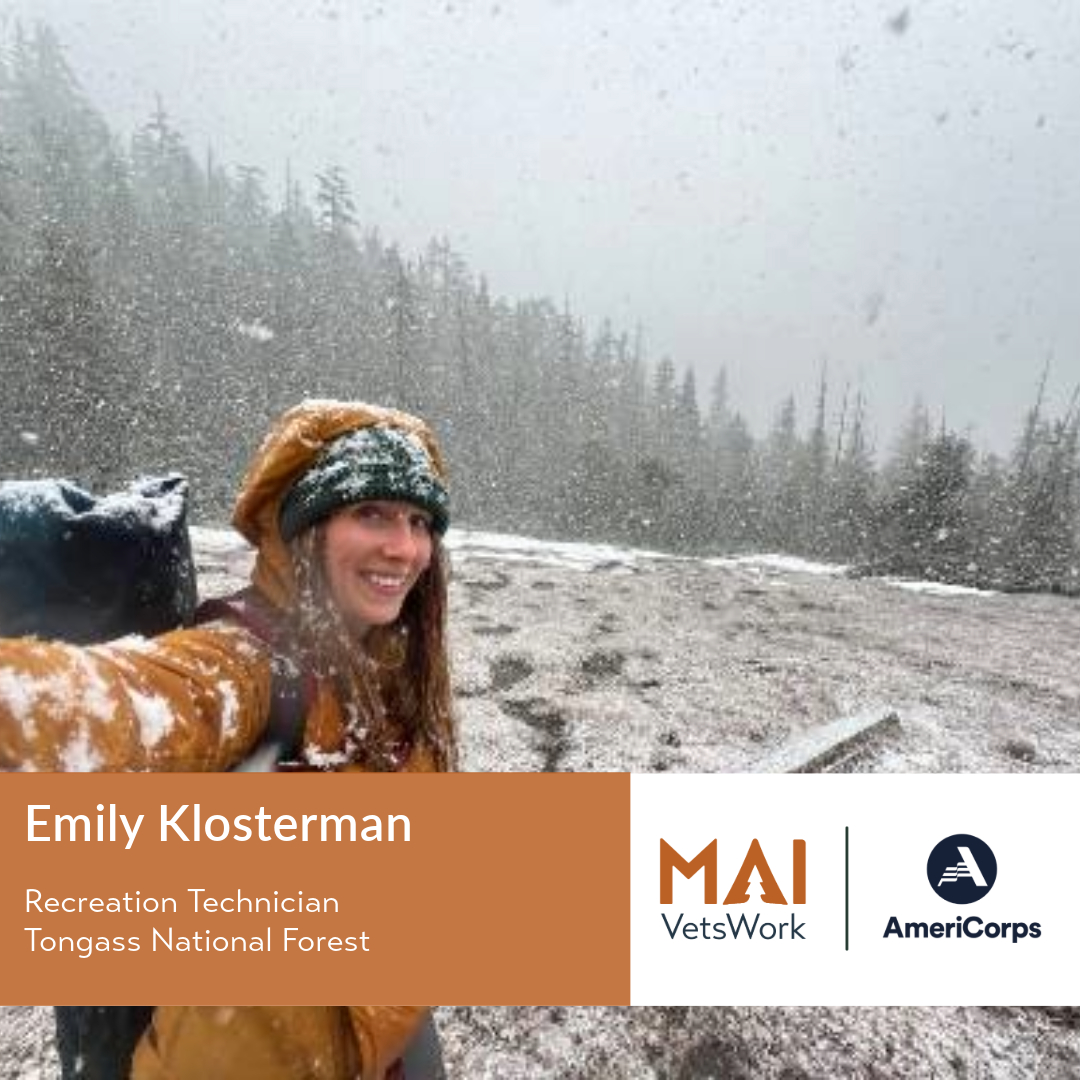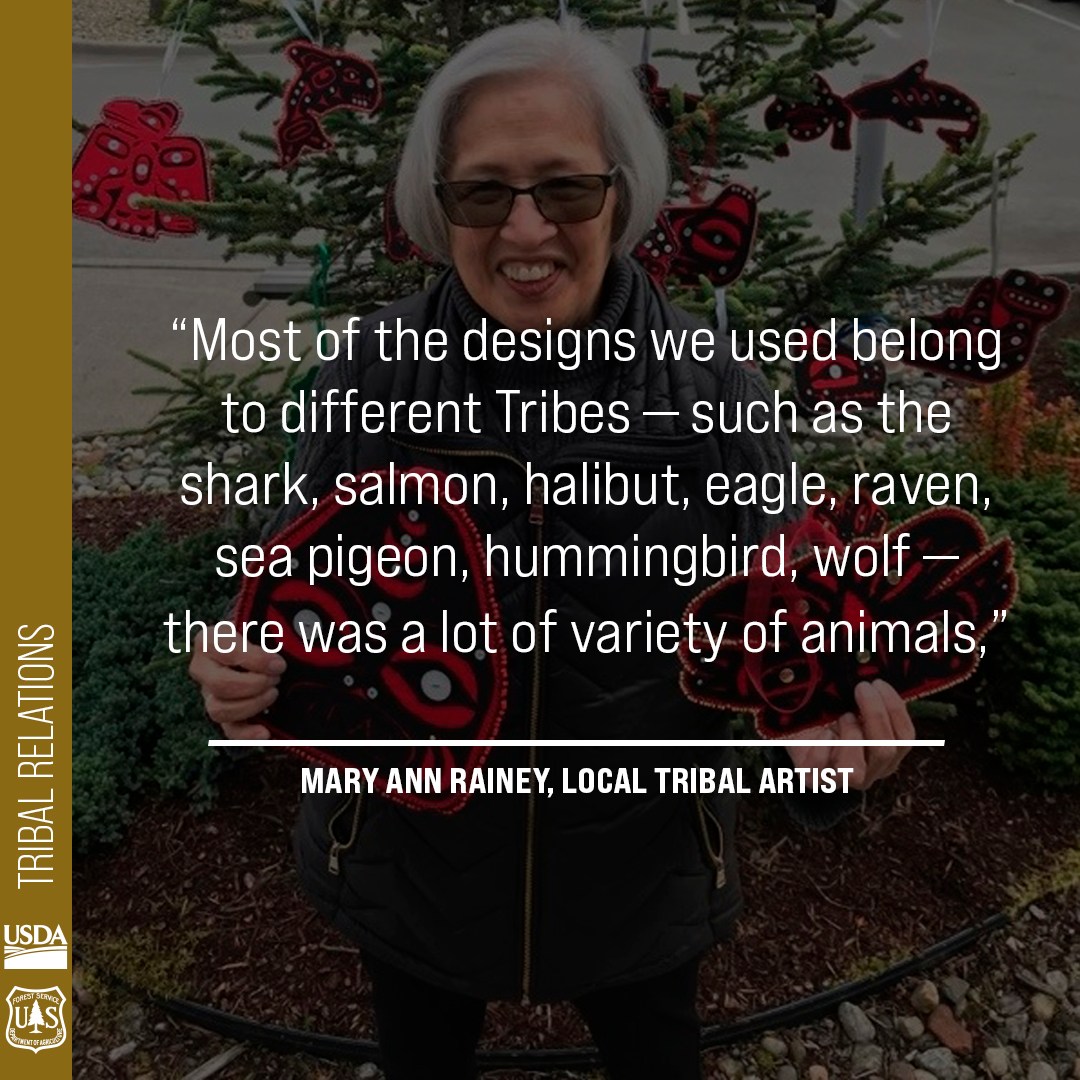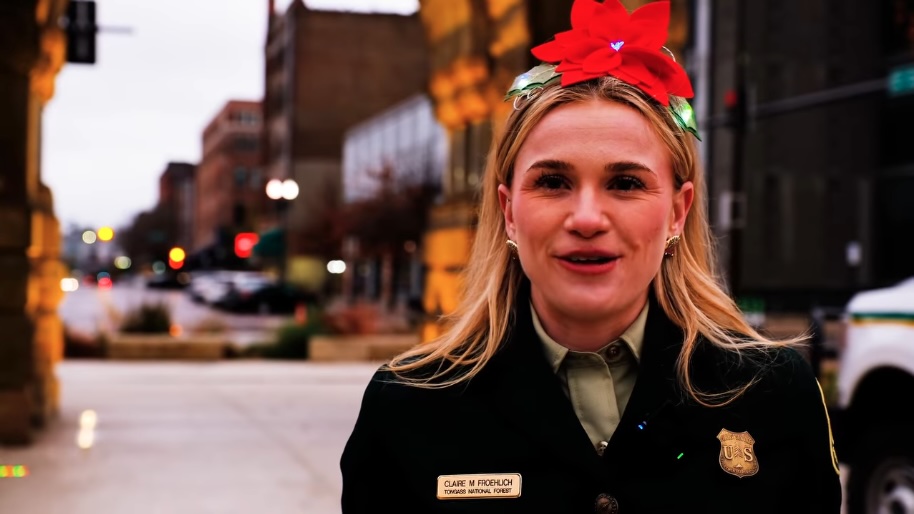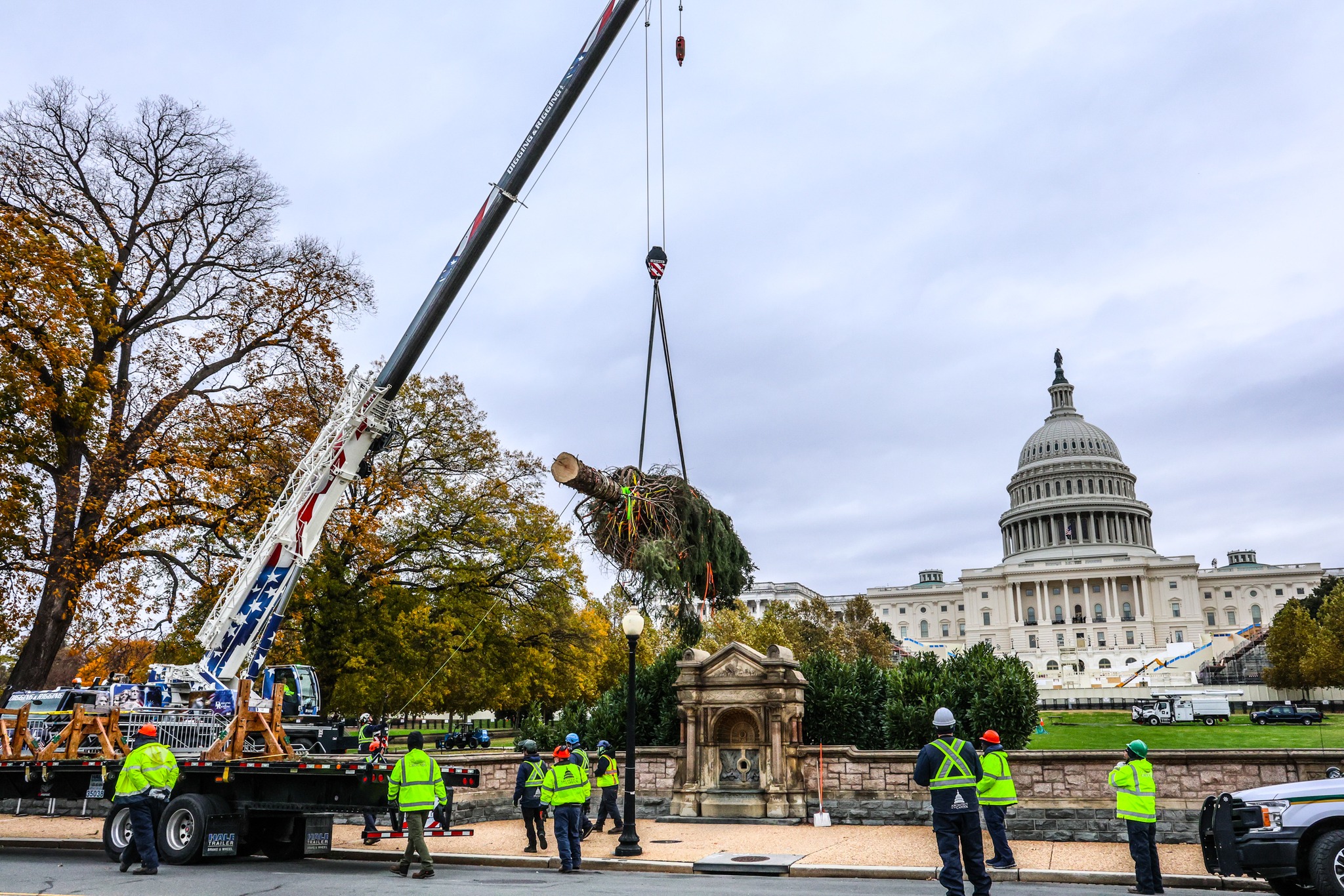
Trout Lake, WA — When AmeriCorps VetsWork intern Emily Kosterman signed on to serve with the U.S. Forest Service, she never imagined she’d play a role in selecting the U.S. Capitol Christmas Tree.
For the past 54 years a different national forest has been chosen to provide “The People’s Tree” for the U.S. Capitol, which includes a public engagement campaign to create connections to and celebrate our national forests.
In this interview, Emily shares the challenges, surprises, and incredible teamwork that happened behind the scenes in order to bring this year’s tree—a 90-foot Sitka spruce from Alaska’s Tongass National Forest—to the West Lawn of the U.S. Capitol.
Meet Emily Kosterman

What were you thinking when out on the hunt for a Christmas Tree for the White House?
Emily: The crew at WRD (Wrangell Ranger District) looked all around Wrangell Island and Zarembo island for the perfect tree. It needed to be 60-100 ft tall, very full and uniform, and a Sitka Spruce. I think at first, I assumed that it wouldn’t be that difficult to find, but we were surprised with the lack of options when factoring in the convenience of tree removal as well. There were some great candidates in hard to reach areas but this tree needed to be near a road system in order to extract it safely.
Crews would split up throughout Wrangell and Zarembo island, find and document their favorite trees that fit the description, and then they were rated in levels of importance based on their metrics and location. The first and favorite tree that was found was on Zarembo island near the road system, but it eventually was ruled out at the last minute due to parasites. So instead of potentially bringing in invasive parasites across the United States, the CCT team had a backup tree that was also conveniently located on Zarembo island near the road system.
Location? Any Bushwacking Involved? Area? How did you haul it out?
Emily: The tree was found on East Zarembo island along the road system so thankfully it didn’t require bushwacking, however, it did require many vehicles, resources, and professionals to safely remove the tree, place on to a barge, sailed back to Wrangell, and then placed on its custom trailer that was built in the summer.
Prior to removal, the area where the tree was located also required a NEPA survey which determined there would be minimal damage to any aquatic life, vegetation, and wildlife etc.
What does it mean to the town of Wrangell?
Emily: I think that this event really put Wrangell and the Tongass on the map for anyone that has followed the CCT journey. It’s a great honor to have supplied the capital with a tree from a remote place in Alaska and on indigenous land. I personally think they could have come up with a better name than ‘Spruce Wayne’ to represent the Tongass but people seem to like it!
What were some struggles?
Emily: The biggest hurdles were gathering the resources needed for this kind of event. It involved many districts from the Tongass and the city of Wrangell to combine efforts to effectively plan, execute and extract the tree. There were also tremendous efforts gathering the ornaments from all over Alaska. All were handmade! Also, promoting its route and stops on social media took months of preparation.

How long did it take to find?
Emily: We started looking in late March and I believe that we found the top 2 candidates by April or May. Many people in timber and silviculture needed to inspect them and verify they fit all the metrics and were able to be harvested safely.
Final thoughts?
Emily: Overall, This was a grand endeavor taken on by the WRD and others within the Tongass. It took a ton of resources, planning, and logistics to make this happen smoothly and safely but more importantly it took a ton of work and sacrifice by the Forest Service employees by giving up so much of their time and work outside of their job.
The History of the People’s Tree

The tradition of the U.S. Capitol Christmas Tree, or “The People’s Tree,” began in 1964 when Speaker of the U.S.House of Representatives John W. McCormack (D-MA) placed a live Christmas tree on the Capitol lawn. This tree lived three years before succumbing to wind and root damage. In 1970, the Capitol Architect asked the U.S. Forest Service to provide a Christmas tree. Since then, a different national forest has been chosen each year to provide “The People’s Tree”, which includes a public engagement campaign to create connections to and celebrate our national forests.
The Christmas Tree Project Today

The process of providing the U.S. Capitol Christmas tree is a year-long undertaking. Among other things, it includes the selection of the People’s Tree, providing up to 60 companion trees for offices throughout Washington, D.C.; partnership with local and state groups in the creation of 10,000 ornaments that celebrate the state’s cultural history and people, landscapes,natural resources, and fish and wildlife; public events during the transportation of the tree to Washington, D.C. and hosting multiple tree lighting receptions in Washington, D.C. in December. Every forest customizes the project to tie it to the local community and state from which the tree comes.
2024 Project Partners
Society of American Foresters
Alaska Geographic
Follow along with the journey on the U.S. Capitol Christmas Tree’s social media.
Alaska’s National Forests

Alaska’s National Forests are two of the Nation’s largest, the Chugach and Tongass – traditional homelands of many Alaska Native peoples. They host tremendous natural beauty with active glaciers, complex ecosystems, diverse plant and animal life, and rich geologic history. They steward a multitude of uses to sustain the people who live here now and future generations. Rich with history and heritage, these forests keep our cultures alive from annual camping trips to traditions that are thousands of years old. Alaska’s National forests are where nature, people, and tradition come together.
Photo: U.S. Capitol Christmas Tree
Tongass National Forest
At nearly 17 million acres, the Tongass is the largest national forest in the United States, and the largest contiguous temperate rainforest in the world. Designated by Theodore Roosevelt in 1907, the Tongass is over 100 years old and a public treasure. is land of beauty, mystery, and untold natural riches covers most of southeast Alaska. Since time immemorial, the Tongass has nourished and sustained rich and unique human cultures. Including the Tlingit, Haida, and Tsimshian peoples. It continues to sustain Alaskan communities and culture today by creating jobs and bringing revenue through tourism, recreation, watersheds, fisheries, mining, and timber. It also includes two national monuments, 13 campgrounds, 19 Wilderness Areas, over 140 reservable cabins and 450 miles of hiking trails. All of this while protecting and maintaining some of the most diverse and beautiful ecosystems in the country.
Chugach National Forest
A breathtaking landscape in the heart of southcentral Alaska, the Chugach National Forest is the northernmost national forest in the Nation. Its 48,000 acres of lakes and 1,800 miles of streams produce 66 million salmon a year or 11% of Pacific salmon production. e Chugach is popularly referred to as Alaska’s “backyard” with three geographic areas known for their pristine ecosystems and seemingly limitless outdoor recreation opportunities. The Kenai Peninsula is considered a hiking paradise and known for its world-renowned fishing on the Russian River. e Prince William Sound area, which makes up almost half of the forest, contains approximately 20 tidewater glaciers, temperate rainforest, and 3,500 miles of coastline. Finally, on the Copper River Delta, millions of waterfowl and shorebirds stop on their way to nesting grounds further north every year – it is considered one of the most essential shorebird habitats in the world.
National Forest Health is the U.S. Forest Service Mission
The mission of the U.S. Forest Service is to sustain the health, diversity and productivity of the nation’s forests and grass-lands to meet the needs of present and future generations. The agency manages 193 million acres of public land; provides assistance to state and private landowners; and maintains the largest forestry research organization in the world. Public lands the Forest Service manages contribute more than $13 billion to the economy each year through visitor spending alone. Those same lands provide 20 percent of the nation’s clean water supply, a value estimated at $7.2 billion per year. For more information, see https://www.fs.usda.gov/.
A Note from Mt. Adams Institute

The U.S. Capitol Christmas Tree project highlights the incredible partnerships and hard work it takes to connect people to the natural world. At Mt. Adams Institute, we see the transformative power of these connections every day through programs like VetsWork, where veterans like Emily contribute to meaningful projects that benefit communities and public lands.
This holiday season, you can help us continue empowering veterans, preserving public lands, and creating opportunities to connect with nature. Your support fuels stories like Emily’s and ensures we can grow our mission in the coming year.

